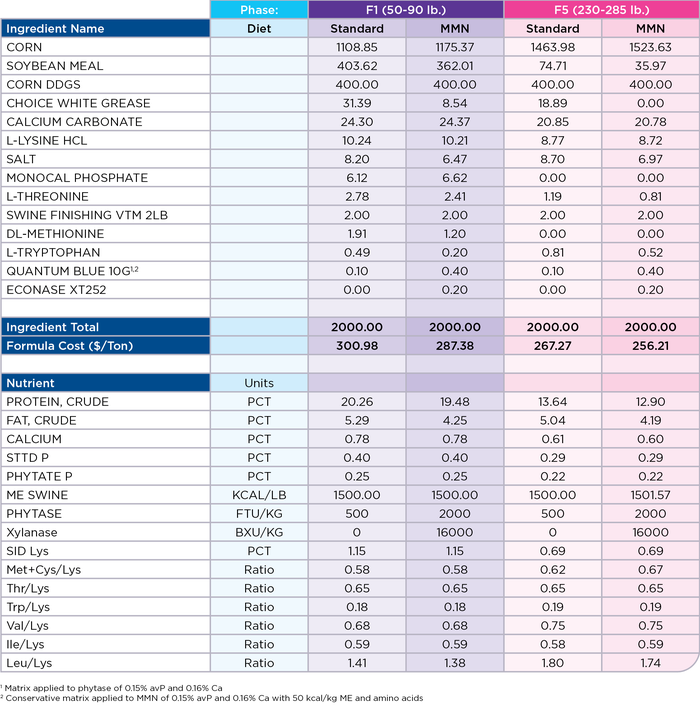Volatility in ingredient prices has nutritionists seeking ways to decrease diet costs.
October 7, 2021

Sponsored Content
Volatility in ingredient prices has nutritionists seeking ways to decrease diet costs. The use of Maximum Matrix Nutrition (MMN), which is the targeted application of superdose phytase combined with xylanase to degrade phytate and non-starch polysaccharides (NSP), is a valuable option for decreasing diet costs while maintaining performance. The combination of xylanase and phytase allows for the elimination of antinutritional factors and improves nutrient utilization. MMN allows nutritionists to use increased mineral, energy and amino acid matrices when formulating diets.
Arabinoxylans (AX) are the major component of NSP in diets containing corn, soy, wheat and DDGS, with AX making up over 50% of the NSP fraction in typical swine diets. Xylanases break down AX, which reduces digesta viscosity and improves nutrient digestibility. Through breakdown of AX to shorter chain xylo-oligomers, xylanases improve intestinal fermentation. When using NSPases, it is important to realize that they can differ in their breakdown products, and NSPases are not necessarily the same. Xylanase indirectly improves gut health by xylo-oligomers stimulating production of beneficial metabolites such as butyrate (Ajuwon et al., 2016; Petry et al., 2021). Xylanase has been shown to improve intestinal and systemic measures of oxidative status (Petry et al., 2020). Entrapped nutrients within the cell wall of feedstuffs are liberated by xylanase (Le et al., 2013), which further improves nutrient digestibility.
Superdosing phytase enables the near complete destruction of phytate as well as the generation of inositol. Phytate reduces nutrient digestibility by binding minerals, proteins and amino acids. Phytate decreases endogenous pepsin activity (Yu et al., 2012), which decreases protein digestibility. Also, phytate increases the endogenous losses of minerals (Woyengo et al., 2012). Therefore, when phytate is degraded, minerals, energy and amino acids (Cowieson et al., 2017) are liberated. Superdose phytase degrades the lower esters of phytate, which decreases their capacity to interfere with nutrient digestion. Superdosing phytase increases ileal inositol levels (Laird et al., 2016), which are correlated to improved performance and feed efficiency. Inositol has insulin-like effects and is associated with increases in serotonin and dopamine, which are linked to reduced stress and increased feed intake (Huber, 2016; Chatree et al., 2020). Superdosing phytase (1500 to 3000 FTU/kg enhanced E. Coli phytase) may increase intestinal glucose transport by upregulating expression of intestinal glucose transporter GLUT-2 (Lu et al., 2020). Taken together with the actions of xylanase, superdosing phytase allows for more efficient nutrient utilization.
As a practical example, Table 1 shows that using the MMN program in early- and late-finishing pig diets can save between $10-$12per ton based on recent ingredient prices (Sept. 2021) and using a conservative nutrient release from the MMN program (0.15% avP, 0.16% Ca; 50 kcal/kg ME and amino acids). Diets were formulated to recommendations from the “2021 PIC Nutrition and Feeding Guidelines,” and feed budgets were estimated using the “PIC Feed Budget Tool” (Table 2). Using MMN with a conservative nutrient matrix allows for the formulation of diets that contain lower levels of added fat, soybean meal and amino acids. These diets would be expected to result in similar performance levels as standard diets saving $3 to $4 per pig.
Superdosing phytase, when combined with xylanase, works together to improve nutrient digestibility and performance. This allows for the use of an increased nutrient release (energy, amino acids and minerals) and the opportunity to maintain performance while saving on diet costs. To ensure success with MMN, it is essential to monitor ingredient levels for available enzyme substrate. The AB Vista Feed Quality Service can provide support regarding ingredient and complete feed phytate, NSP and other nutrient levels.
Table 1. Finishing diets using phytase Ca and P matrix.

Table 2. Applying a MMN approach to a standard finisher pig program using PIC model as a reference

About the Author(s)
You May Also Like



